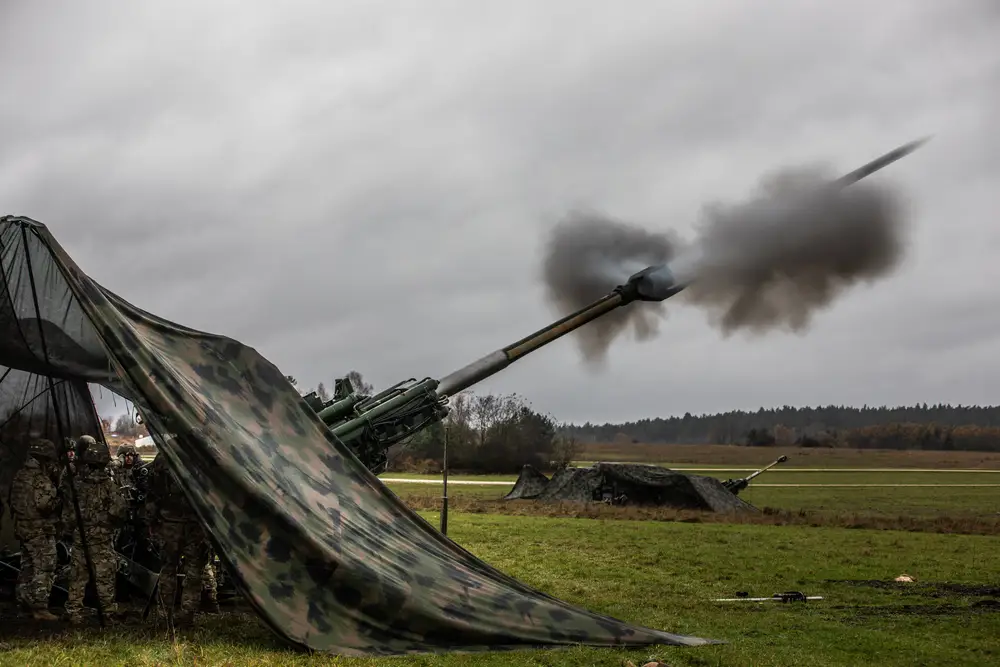The US is finally going to make a key explosive at home, and that’s good news for the military

US Army soldiers fire a 155mm artillery round from their M777A2 howitzer during a live-fire exercise in Germany on November 19.
The US intends to start making TNT at home again. It’s a critical step as the military prepares for the possibility of a protracted great-power conflict against a nation like Russia or China.
The US Army plans to build a domestic production facility for the explosive compound, which the Pentagon has long been forced to obtain from overseas.
TNT, short for trinitrotoluene, is a widely used highly explosive material that serves as an important ingredient for bombs, grenades, and artillery shells like the 155mm shells that have been used extensively in the Ukraine war to the point of straining Western stockpiles.
The US hasn’t produced TNT on American soil in decades, but that is changing. Production is coming back. Last week, the Army announced that it had awarded REPKON USA-Defense LLC a contract worth up to $435 million to design, build, and launch a TNT production facility in Kentucky.
Army officers and defense experts told B-17 that the new facility, which is expected to be commissioned in 2028, will strengthen the US industrial base and reduce the risks of depending on supplies from partners overseas. In conflicts, supply chains become more vulnerable and potentially less stable. Making essential materials at home better insulates them from external effects.
Maj. Gen. John T. Reim, head of the Army’s Joint Program Executive Office for Armaments and Ammunition, told B-17 that “the ability to produce TNT domestically ensures a steady, reliable supply of this critical explosive material.”

A US soldier moves a 155mm round to load a howitzer during live-fire exercises in Germany in February.
“This reduces dependence on foreign sources and mitigates risks of supply chain disruptions,” he added. “With a steady supply of TNT, the Army can sustain and scale up munitions production as required.”
And there’s growing evidence from the war in Ukraine that the US would need to significantly ramp up munitions production in a major conflict. As is, the US military is already rethinking how much ammunition it really needs and how much larger stockpiles potentially need to be, especially for a long conflict.
“The volume of weaponry — the number of missiles and other systems that are going to be required to deal with a high-end conflict — are just much more than we had planned,” Bradley Martin, a retired Navy surface warfare captain, recently told B-17 about what the current conflicts say about ammunition and firepower needs.
“We also lack the industrial base to rapidly expand,” he added. “So it’s really important that we start addressing those sets of issues quickly.”
The US has transferred over 3 million 155mm shells to Ukraine as part of the $60 billion in security assistance that it has given to Kyiv, prompting the Army to dramatically step up production of these key shells to meet demands.
Before the war, the US was making somewhere around 14,000 shells a month. Officials have said that they want the figure to eventually reach 100,000. This requires significantly more TNT, the primary fill for a 155mm round. The US hasn’t made TNT at home since 1986 and, instead, relies on countries like South Korea and Poland to supply the explosive material.

155mm shells have been key munitions in Ukraine’s defense against Russia.
European countries providing Ukraine with artillery shells are also rushing to scale up production of munitions and explosives as they, like the US, continue to supply Kyiv.
Cynthia Cook, director of the Defense-Industrial Initiatives Group at the Center for Strategic and International Studies think tank, said that increasingly contested logistics and global political issues make America’s dependence on foreign sources a greater strategic risk. Restarting domestic TNT production is an investment in the country’s industrial base, she said.
She told B-17 that “the inadequacy of investments in the munitions industrial base and munitions production have been revealed by the US and allies support of Ukraine in its self-defense against Russia’s illegal invasion.”
“The US has recognized that it needs to prepare for more protracted conflicts, and an increase in munitions production and the munitions supply chain are important parts of that story,” Cook said.
Indeed, a future fight against a near-peer adversary might not resemble the swift victory of Operation Desert Storm, instead looking more like what is playing out in Ukraine today.
That demands a new approach to readiness. The new TNT production facility is expected to help strengthen the US military’s preparation for large-scale conflict. “Ensuring a secure and domestic supply of TNT bolsters the US’ abusinlity to support warfighter readiness,” Reim said.






